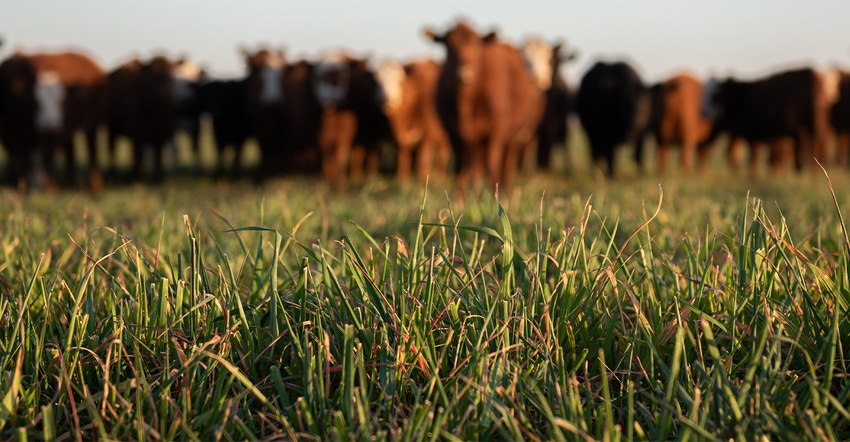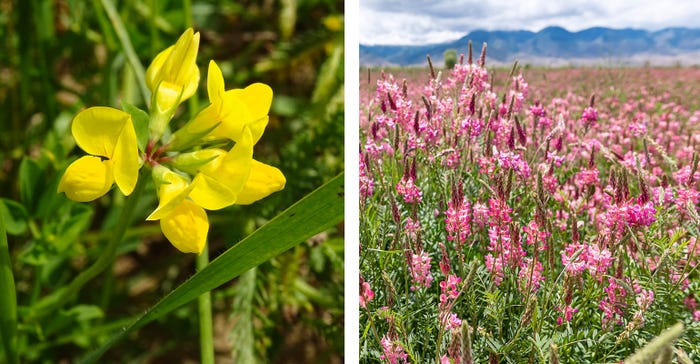December 23, 2019

For farmers and ranchers, the lack of more land appears to constrain business expansion and boosting profits. But you can increase the stock capacity of your ranch business without buying more land.
First, set a grazing plan in motion for your livestock on rangeland and irrigated pastures.
Second, evaluate the forage quality and quantity of your irrigated pastures. Adding a legume or legumes to irrigated grass pasture raises plant yield — and the nutrition value for your livestock.
To increase stock capacity on your rangeland or irrigated pastures, manage when and where your livestock graze. First, implement a grazing plan that mimics the natural ecosystem. Focus on how to reduce the amount of time that livestock graze a certain area. At the same time, multiply the number of stock, or grazing density, in that area.
“All of the grasslands in the world evolved with migrating grazing animals,” says Tony Malmberg, a rancher near Union, Ore. “In the northern Great Plains, it was bison; in the Pacific Northwest, elk and bison. But everywhere there were grasslands, there were migrating herds. Rangelands evolved with herds migrating; and if you want those lands to perform, you must mimic nature.”
Malmberg recommends basing your grazing plan on the length of plant recovery periods. If grasses and forbs in a riparian area are grazed longer than 30 days, the plant yield and soil organic matter drops. When livestock graze the same plants for a time period between 21 days and 30 days, the plants will maintain their yield.
When plants sustain continuous grazing less than 21 days, grass moves down to the high-water mark, trees and other woody plants increase, and the water channel narrows. All of these raise the health of the ecosystem and result in higher grass yield.
Also, consider how cattle eat grass and forbs. On irrigated pasture, plants thrive when 4 to 6 inches of plant matter remains after grazing to capture sunlight. “Cattle wrap their tongue around the grass to taste it,” Malmberg explains. “Then they lift their heads to cut off the grass to leave 4 to 6 inches. If you move cattle to a different area after one bite per plant, there is enough plant material left to photosynthesize and grow easily.”
He says that if cattle return to graze that same plant, they use the “chomp” method. “They bite down and pull, and it takes the plant down to a half an inch above the soil. This stunts the plant and forces it to regrow from plant root reserves.”
Livestock will graze some plants to 4 to 6 inches, chomp a selection down to half an inch, and leave others untouched. Malmberg says the way to get cattle to graze plants in a level manner is to increase stock density and reduce the amount of time that the animals graze an area. He recommends regularly scouting plant soil condition to inform your grazing plan.

BOOSTING PASTURES: Grasses create a great base for feeding livestock, but "juicing" pastures with legumes like birdsfoot trefoil (left) or sainfoin allows you to boost stocking rates. These legumes fix nitrogen, but have high enough tannins to be non-bloating.

Benefit of non-bloat legumes
On irrigated grass pasture, consider interseeding non-bloat legumes, which — along with your grazing rotation that allows for plant recovery — will increase plant yield and stock capacity. Legumes fix nitrogen in the soil, boosting grass yield. Utah State University researcher Jennifer MacAdam finds two legumes, birdsfoot trefoil and sainfoin, are excellent additions to grass pastures. They hold nutritional value like alfalfa, but the tannins in these high-protein legumes prevent bloat.
Research found that grass yielded higher plant mass in a grass-legume mix than in a nitrogen-fertilized grass monoculture. “The grass came to life when it had the legume companion,” says MacAdam, a USU professor of plant physiology and forage production. “It’s pretty profound to have higher yield of the grass in the mixture than in the monoculture under fertilization.”
Both birdsfoot and sainfoin readily establish and sustain themselves in grass mixes. The optimal grasses to mix with legumes are meadow bromegrass and tall fescue, according to USU’s tests. Orchardgrass is a poor companion grass because its tillers out compete legumes.
Legumes can be mixed with grass in a new seeding or drilled into existing grass pasture. To interseed in an existing stand of grass, researchers find that legume seeding benefits from stunting the grass beforehand. This can be achieved through intentionally overgrazing the pasture with livestock to check the grass while the legumes sprout. Or, it’s possible to spray a light application of the herbicide glyphosate to achieve the same effect.
When and where livestock graze must be managed for successful, sustainable pastures, regardless of plant mix. Rotating cattle every two weeks according to plant recovery periods seems more costly than moving cattle every couple of months. Malmberg finds that increasing stock density concentrates the labor of fencing and water into a single area to streamline work. The resulting increases in grass yield support more cattle to heighten the cash flow. “If you consciously minimize overgrazing, increase stock density, cover the soil surface with living and dormant plant matter, and think about plant recovery, the landscape will improve,” Malmberg says,
Learn more about increasing stock capacity and holistic management at Malmburg’s blog, holisticmanagement.guide.
Legumes and the finished product
USU also spearheaded research on how cattle finish on grass pasture, birdsfoot trefoil legume pasture and feedlot grain rations. For the study, yearling cattle of similar genetics were fed out on grass, legume and grain diets, and processed at 18 months.
Results showed that carcasses of the legume- and grain-finished cattle weighed about the same. In the West, legumes accumulate carbohydrates that, when consumed by cattle, build more intramuscular fat than grass rations. The cattle that grazed legume pasture held a higher dressing percentage than diets of grass and grain. Within the constraints of the study’s time frame, the grass-finished cattle ranked lighter than the legume- and grain-finished.
“Some consumers don’t want animals in feedlots,” MacAdam says. “With non-bloat legumes, yearlings can be pasture finished in essentially the same time frame as in feedlots.”
A sensory panel of people evaluated, in a blind taste test, the effect of the three diets on the final beef cuts. The panel ranked the grain-finished beef the highest, though this may be from it tasting similar to what the participants normally eat (95% of U.S. beef is finished on grain). Participants listed the legume pasture-finished beef in second place, or as similar in taste to grain-finished.
“Typically, people that don’t like grass-finished meat find it’s dry,” MacAdam says. “I think consumers will love the tender, juicy meat finished on legume pasture.”
Studies suggest that the tannins from legumes like birdsfoot trefoil lessen the grassy, pastoral flavor and aroma of meat. Birdsfoot consists of 1% to 2% tannins; sainfoin, 3% to 5%. Legumes mixed with grass also raises pasture yield for increased stocking capacity and pasture-finishing meat livestock.
Hemken writes from Lander, Wyo.
About the Author(s)
You May Also Like




